Analysis of a Decade of Israeli Judicial Decisions Related to Data Protection (2012-2022)
Adv. Rivki Dvash with the assistance of Mr. Guy Zomer1
Background
The Future of Privacy Forum’s office in Tel Aviv (Israel Technology Policy Institute – ITPI) sought to examine the judicial decisions in civil actions under Israel’s Privacy Law, which includes rules that regulate data protection. We examined the extent to which the general public demands protection of the right to privacy through judicial proceedings. We also analyzed the privacy and data protection issues that concern the public enough to appeal to the court, as well as identified any patterns in the appeals.
It is important to note that there is a contradiction inherent in taking civil actions to remedy privacy and data protection violations since appealing to judicial bodies brings attention to and publicly catalogs the disputes. 2 As such, there is an occasional interest to not pursue these matters in order to prevent additional publication or exposure of information that could increase the harm of the initial violation of privacy. Accordingly, the data gathered in this analysis does not necessarily reflect the complete interest and desire the public has in protecting privacy, but rather the cases in which individuals chose to seek judicial remedy under the Privacy Law.
In order to examine all of these cases, we asked Mr. Guy Zomer of Octopus – Public Information for All (R.A.) – which works to make public information, including that related to judicial proceedings, accessible through the Tolaat Hamishpat – to compile all the rulings since 2012 that mention privacy violations and retrieve relevant metadata for our analysis.
The overview below highlights the information and insights gathered from the metadata.
Methodology
Collection of rulings from the Nevo website
In order to locate rulings related to privacy violations, we queried all published rulings issued from January 1, 2012, to December 31, 2022 to find those that included reference to Section 2 of the Privacy Law, 5741-1981 (from now on referred to as “the Law”), which defines an invasion of privacy and what constitutes a civil tort (and a criminal offense). The dataset only includes rulings issued in ordinary courts (magistrate, district, and supreme), and not those issued in special courts such as the Family Court and the Labor Court.
Initial screening
Since we wanted to concentrate on civil proceedings to discover common patterns, we removed criminal judgments and appeal proceedings from the dataset. We also chose to examine and compare decisions related to class actions separately from other civil proceedings.
We identified a total of 293 judgments issued in civil lawsuits and 29 judgments in class actions that referred to privacy violations.
Data collection
The dataset of civil claim decisions related to privacy violations initially only contained primary data such as the opening and closing dates of proceedings and the amount of the claims. We then added the following secondary data:
- The additional grounds in the civil lawsuit (defamation, spam, etc.), if any;
- The specific grounds for which the claim was filed (in other words, which subsection of Section 2 is used), even if the court did not recognize the requested cause or all the grounds for which the claim was filed;
- The relationship between the plaintiff and the defendant (neighbor, employer-employee3, family, etc.);
- Whether the plaintiff claimed concrete damage or compensation without proof of damage;
- Whether the court recognized defense claims (this refers to the acceptance of defense claims in a judicial decision, and not to the fact that the defending party raised them);
- Who won the lawsuit;
- The amount of compensation mandated due to the violation of privacy;
- The amount of expenses that have been mandated; and
- The total amount of compensation that was mandated, including expenses or other grounds.
We examined class action cases separately from civil lawsuits since class actions focus more on potential harm to a group of people rather than an individual and the monetary compensation is structured differently with three components: individual winnings, group winnings, and lawyer fees, which are higher than is usually customary and serve as an incentive to file class actions.
Preliminary research findings
1) It should be noted that the data we examined only related to published judgments. We have yet to learn about the number of relevant claims in which the proceedings were stopped for various reasons (such as a settlement or lack of legal proceedings by the plaintiff or closed-door proceeding). Given that there is no labeling of privacy protection procedures in the Net HaMishpat (the computerized system for managing court cases in Israel), it is impossible to locate such information.
2) There is a small number of verdicts related to privacy violations and there are only several dozen privacy cases yearly. In comparison, in 2019, about 200,000 cases were closed in the Magistrates’ and District Courts. 4 Furthermore, in 2020, about 192,400 cases were closed in these courts. 5 In other words, the judgments in matters of privacy in Israel are a negligible percentage of all civil proceedings.
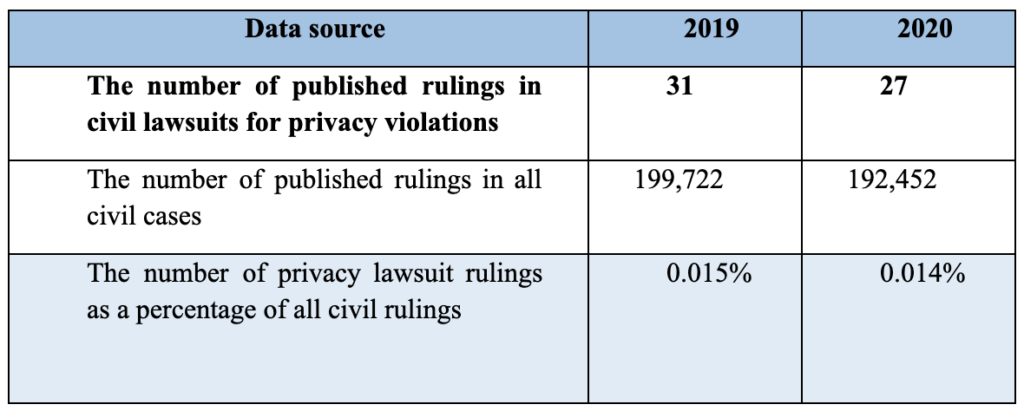
3) We looked at the approximate weight of published privacy violation claims as a percentage of total published civil lawsuits over several years to see whether there are any patterns. Although this method is not statistically accurate, it is still useful to examine the variable ratio between all judgments and privacy judgments published in Nevo.
However, even in the test mentioned above, we could not locate or indicate a clear trend, as seen below.
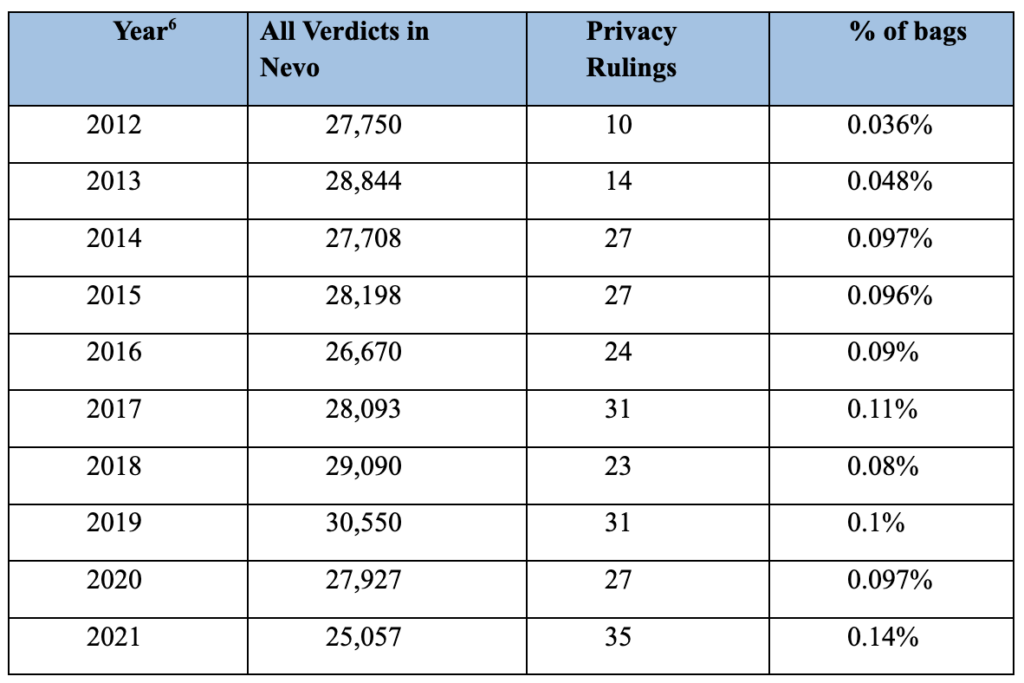
Findings
Civil Lawsuits
1. In all the cases, except for one,7 the plaintiffs preferred to claim compensation without proof of damage under section 29A of the Law.
2. The most common issue in civil lawsuits is the photographing of a person and placing of cameras in public, and sometimes even private spheres, accounting for 5.1% of claims.
3. We did not find any civil lawsuits for torts from privacy violations in databases. The initial assumption was that such claims are found in class actions (see below).
4. Civil lawsuits for privacy violations were generally connected to legal claims for other torts. Less than 20% of the claims filed for privacy violations were filed as a single damage (17%).
5. 19.8% of plaintiffs chose to file their claim in “Small Claims Courts,” which allow for relatively quick and no-frills compensation in an amount limited to up to NIS 36,400 (roughly USD 10,000).
6. The main ground for civil lawsuits is the “spying on or tracing of a person,” or other harassment. This ground appears in 36.9% of civil court rulings. For context of how dominant this cause is, the second most common ground (photographing a person without their permission) is cited in only 16% of all judgments.
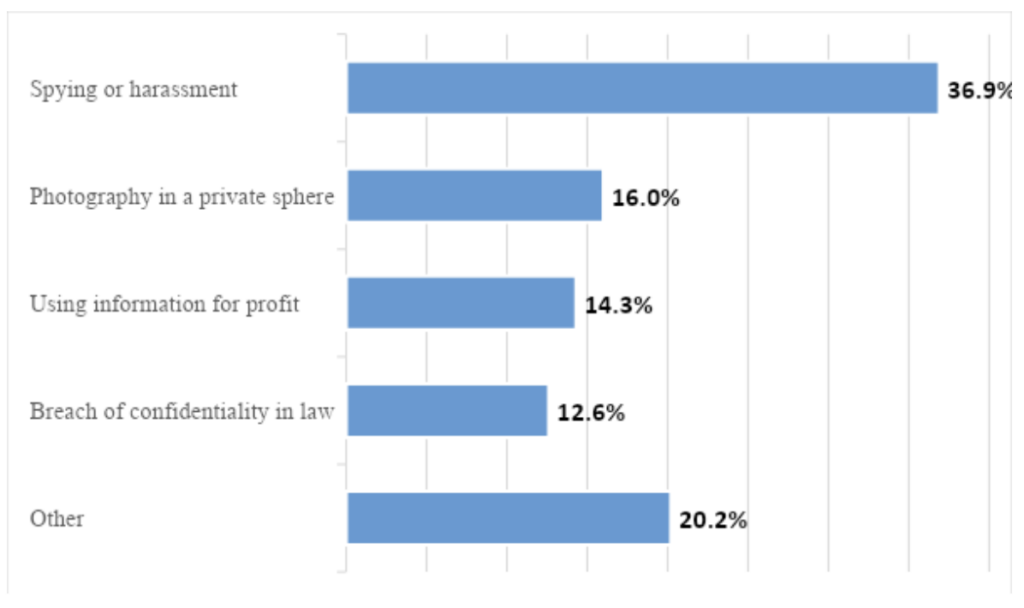
7. The most common relationship between plaintiffs and defendants is a consumer relationship (24%) or a neighbor’s dispute (21.8%). A citizen’s claims against the authorities account for 8.9% of all claims, with the leading cause of action for this type of relationship being a breach of the confidentiality obligation established by the Law (40%).
8. Although privacy violations from media exposure create significant harm due to their broad exposure of information, only a low percentage of filed claims are due to this type of violation (7.5%). Additionally, claims due to this type of violation are always accompanied by a civil lawsuit for other claims such as defamation. Generally, defamation claims appear next to privacy violation claims (52%).
9. 9.9% of privacy claims also involved spam claims filed under Section 30A of the Communications Law. This finding is interesting because during the legislative process for spam regulations, it was determined that they should be incorporated into the Communications Law instead of the Privacy Law. Regardless, even in decisions that recognized both privacy and spam violations, the compensation amounts remained extremely low (no more than a few thousand shekels).
10. In most cases (57.3%), the plaintiff won the claim, compared to 34.4% of cases in which the defendant won (in the other claims, there was no definitive decision). However, a deeper examination of these claims shows that only 46.7% of them were compensated for the privacy violation. In other words, sometimes the plaintiff won the case, but not on the grounds of the privacy violation, or general compensation was provided without specifically referring to the privacy violation.
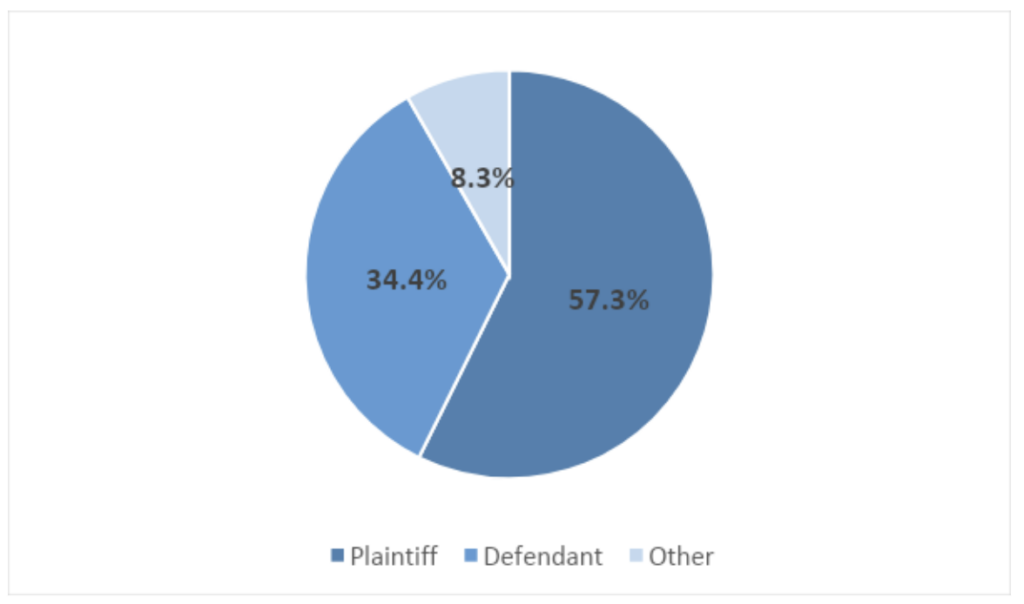
11. In almost a quarter of the rulings (24.5%), the court recognized legal defense protections under the Law. 9 The most recognized protection (40.3%) is in the case of “legitimate personal interest” (section 18(2)(c)).
Class Actions
12. Class actions related to privacy violations (29 cases) account for a small number of all class actions (6493 cases). However, the relative share (4.5%) is larger than the ratio of civil privacy violation claims compared to all civil claims (about 0.09%). This larger relative share is even more significant given that privacy violation class actions in Israel are more limited tools than civil lawsuits since class actions can only apply to the specific types of claims listed in the second addendum to the Class Actions Law, 5766-2006. 10
13. Most of the class actions that include grounds for privacy violations are also related to consumer protection.
14. Spam violations constitute the additional (or, more precisely, the primary) ground in a significant share of privacy violation class actions (69%). Four cases (15.4%) also mentioned the issue of registering the databases that are the subjects of the claims.11 Furthermore, in four cases (15.4%), it was claimed that the information security of the databases in question were compromised.
15. In 17.2% of privacy violation cases the court rejected the motion to file a class action.
16. Of the 29 cases in which a judgment was given (including court rejection to form a class action), in 41.4% of cases, the court approved the settlement, and in 37.9% of cases, the court approved the plaintiff’s motion for leave.
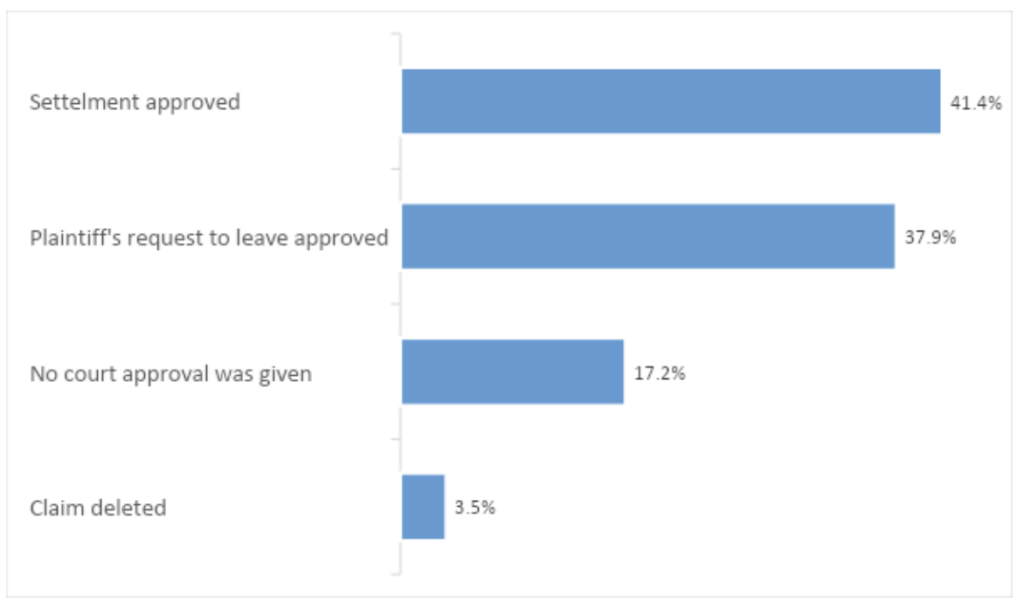
17. 69.2% of claims ended in favor of the plaintiff, and only about 26.9% of the decisions favored the defendant, with plaintiffs liable for expenses in only four cases (15.4%).

Conclusion
Despite the difficulty in getting clear insights into privacy violation civil lawsuits and class actions due to the scarcity of rulings in this area, it is still necessary to examine these decisions.
The small number of claims in this area may indicate the public’s lack of interest in exercising its right to compensation when privacy violations occur. Part of this disinterest is likely due to the desire to prevent additional publication or exposure of information that could increase the harm from the initial privacy violation. Interestingly, the larger amount of privacy violation class actions as a percentage of all class action lawsuits (compared to civil lawsuits) indicates that given a larger financial incentive and decreased risk of exposure of individuals’ personal information, the desire to file lawsuits may increase. This tentative hypothesis is supported by the higher numbers of class action and civil lawsuits related to spam violations, both of which have high compensation potential and do not reveal additional personal information about plaintiffs. However, given the small absolute number of both class action and civil lawsuits related to privacy violations, more research is needed to fully examine the motivations of plaintiffs.
Even with the small number of claims, there are still several interesting findings, including clarity into the types of privacy violations that concern the public. For example, it is evident that plaintiffs mostly bring violations related to neighbor disputes and placement of cameras in public spaces for surveillance. The research also shows that despite the higher potential for privacy violations from state authorities or the greater harm from violations of database-related provisions of the Law, there are almost no lawsuits concerning these issues. One potential hypothesis for the lack of these claims is that there are power gaps between citizens and authorities, as well as data subjects and database owners, that disincentivize lawsuits. Although class actions can strengthen the power of the consumer, they still require proof of damage and also cannot be filed against the state.
In conclusion, it is impossible to point to a change or a clear trend of citizens exercising their right to privacy in civil lawsuits over the past decade.
Editor: Isabella Perera
This text has been translated and adapted into English from the original report published on January 30, 2023, available in Hebrew following this link.
1 Thanks to Adv. Limor Shmerling-Magazanik, former Director of ITPI, for her comments on this report.
2 In Israel, the default is that legal proceedings are published stating the parties’ names.
3 It should be noted that even in civil proceedings in ordinary courts (not the Labor Court), we still found claims related to employee-employer relationships.
4 See Annual Report 2019 – Court Administration (in Hebrew), pp. 25 and 37. In the district courts, 8,278 civil cases were closed, and in magistrates’ courts, 191,444 such cases were closed.
5 See Annual Report 2020 – Court Administration (in Hebrew), pp. 25 and 37. In the district courts, 7,578 civil cases were closed, and in magistrates’ courts, 184,874 such cases were closed.
6 We did not include 2022 because there was a change in the classification of cases in civil lawsuits that altered how the selected group was sampled.
7 Civil Action (Magistrate court – Haifa) 54043-11-12 Naor v. Clal Pension and Provident Fund Ltd. (11/4/2014) (in Hebrew), in which the plaintiff lost.
8 As of January 2023.
9 Section 18 of the Privacy Law.
10 Such as dealers, banking corporations, financial services providers, etc.
11 In Israel, there is still an obligation to register databases.
